Inground Swimming Pools
Swimming Pool Equipment
There’s so much more to choose than just the shape and type of pool. Once you’ve chosen the pool you’ll need to consider pool equipment and options. In order to have clean and clear swimming water you’ll need a combination of circulation, filtration, and sanitation. Some of the equipment that you’ll be asked to consider and choose include:
- Pool Pump – The pool pump is heart of the filtration system as it does the hard work of pumping water from the pool, through the filtration system and back to the pool. The number of options, Brands, and sizes of pool pumps will surely make your head spin! I relied heavily on the recommendation of our pool company to offer us a pump that was properly sized, Energy Star certified, and reliable. The pump we chose included a built-in program that allows us to program the run time for better energy savings. The pump is also a variable speed pump which allows the user more control depending on the demand required (if we’ve got a big group using the pool, I’ll crank up the speed to improve the filtration rate). Pool pumps are available in both 110V and 220V models so you’ll want to discuss the pro’s and con’s with your electrician.
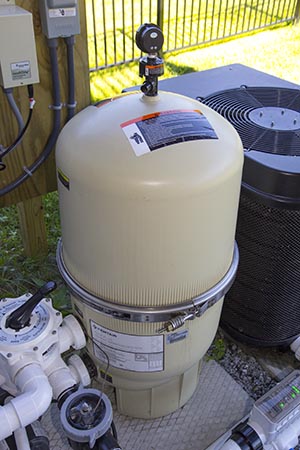 Pool Filter – The pool filter does all the dirty work and helps keep the water clean and free from debris and small particles. There are three main types of pool filters to consider including: Diatomaceous Earth Filters (DE), Sand Filters, and Cartridge Filters. Probably the most important thing to consider is the filter size. Always choose a filter that’s one size larger than you need in order to ensure good filtration. Diatomaceous filters are the most efficient filters on the market, capable of filtering particles as small as 3-5 microns! Diatomaceous powder must be added to the filter after each backwash (1-3 times per Summer) and the filters must be cleaned annually. Sand filters trap particles in the 20-100 micron range and require less maintenance than a DE filter with the sand only being replaced about every 5-7 years. Cartridge filters trap particles in the 25-100 micron range and work much like an air filter. Instead of backwashing the filters are replaced when they become clogged with debris. For our new pool we chose a Diatomaceous filter and it’s worked very well.
Pool Filter – The pool filter does all the dirty work and helps keep the water clean and free from debris and small particles. There are three main types of pool filters to consider including: Diatomaceous Earth Filters (DE), Sand Filters, and Cartridge Filters. Probably the most important thing to consider is the filter size. Always choose a filter that’s one size larger than you need in order to ensure good filtration. Diatomaceous filters are the most efficient filters on the market, capable of filtering particles as small as 3-5 microns! Diatomaceous powder must be added to the filter after each backwash (1-3 times per Summer) and the filters must be cleaned annually. Sand filters trap particles in the 20-100 micron range and require less maintenance than a DE filter with the sand only being replaced about every 5-7 years. Cartridge filters trap particles in the 25-100 micron range and work much like an air filter. Instead of backwashing the filters are replaced when they become clogged with debris. For our new pool we chose a Diatomaceous filter and it’s worked very well.- Sanitation – Pools need chemicals in order to maintain proper sanitation so swimmers don’t get sick. Traditionally, pools have long been treated with chlorine by added chlorine tablets to the skimmers, liquid chlorine, or a combination of both. This method still works well but it can be difficult to manage properly and dangerous (chlorine can burn the skin, ruin clothing, and potentially cause serious injuries). A more modern approach to sanitation is using a salt-chlorine generator that creates chlorine using salt water. The pool is dosed with table salt (NaCl) at a rate of roughly 25lbs/1000 gallons (much less salt concentration than the ocean if you’re thinking along those lines). A salt water chlorinator uses electrolysis to create chlorine which generates the hypochlorous acid. This form of chlorination doesn’t irritate eyes, doesn’t fade clothing, and leaves your skin feeling softer and less irritated than traditional chlorine applications. The initial cost does take time to pay off but it’s well worth the investment and the convenience is huge. We chose a salt water chlorinator for our pool and it’s been the best investment I can think of.
- Vacuum System – Part of regular pool cleaning involves vacuuming the bottom of the pool to remove sediment and debris that doesn’t make it’s way into the filtration system. Pools typically need to be vacuumed at a minimum every week or so in order to keep the bottom looking clean. The “old fashioned” approach is simple and includes a vacuum hose that connects to the pool skimmer, a long pole, and a vacuum head. Today there’s a much better approach that uses small “robots” to clean the pool floor. There are all sorts of robotic pool cleaners on the market that clean your pool while you’re doing other chores! Most robotic pool cleaners will also need a booster pump. We chose a Polaris Robotic Pool Cleaner and it does an amazing job.
- Pool Heaters – If you’re going to invest in a beautiful inground swimming pool then you should consider a pool heater. Even if you live in Florida a pool heater will extend the pool season considerably. Pool heaters fall into three categories including:
- Gas Heaters – Gas pool heaters can be run on natural gas or propane and offer the quickest way to heat a pool. Gas heaters are also typically the cheapest heater to purchase and install. Depending on where you live and the current price of gas the price to operate this heater will surely ramp up your monthly utility bill so be prepared.
- Electric Heaters – Before you panic about using electricity I’m talking about a heat pump. Today’s heat pumps are energy efficient and very competitive with gas heaters. In fact, in some situations an energy efficient heat pump can be cheaper to operate than a gas fired heater. The initial cost of a heat pump is typically more than a gas heater, but long term cost savings should be evaluated as an option. Heat pumps do take longer to heat the pool, but without the need for a gas supply or exhaust they can be a great option on tight sites. For our pool we chose an energy efficient heat pump. The first Summer has been quite cool so the cost to heat the pool has been a bit of an eye opener! Warm water in the pool is definitely a plus.
- Solar Heat – Capturing the suns energy has never been easier and heating a pool is a great way to take advantage of that free energy source. Solar pool heating systems are an excellent option especially in warmer climates where the system doesn’t have to be winterized. Solar panels are typically mounted on a nearby roof or frame in the yard and tied into the regular water circulation system. This is something I’ll be evaluating and looking into next season as a way of cutting our electric use for the pool heater.
- Pool Covers – Another item to consider is a pool cover. Here in New England our pools get winterized and covered for the Winter. A pool cover keeps out leaves and debris and also provides protection from people falling into the pool. Solar covers are also a great option during he Summer to help keep heat in the pool when not in use. Keep in mind that odd shaped pools can be more difficult and costlier to cover.





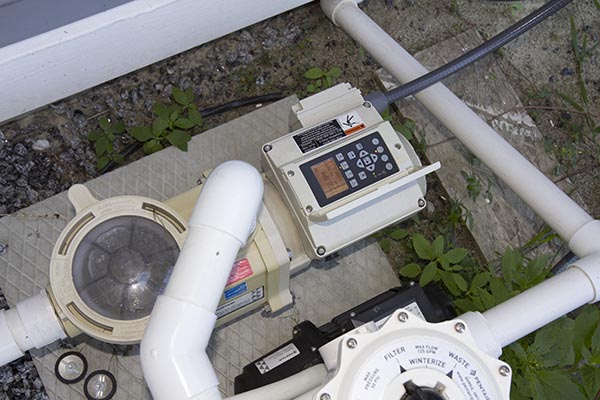
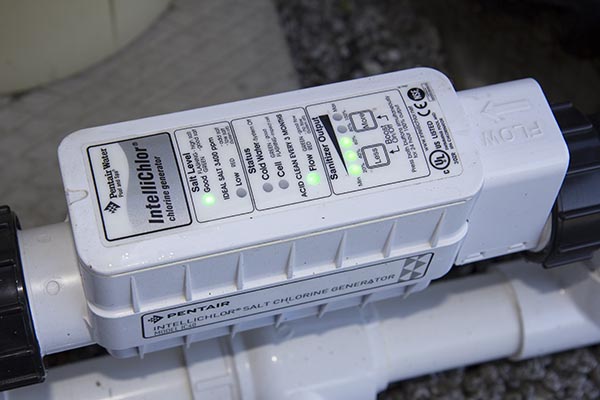
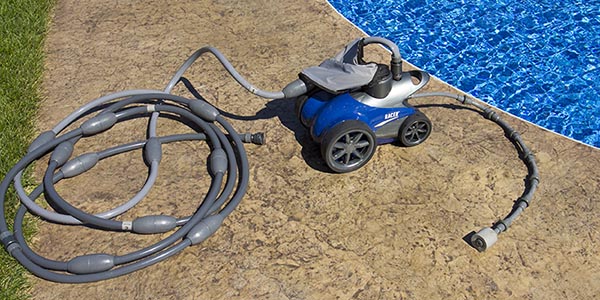
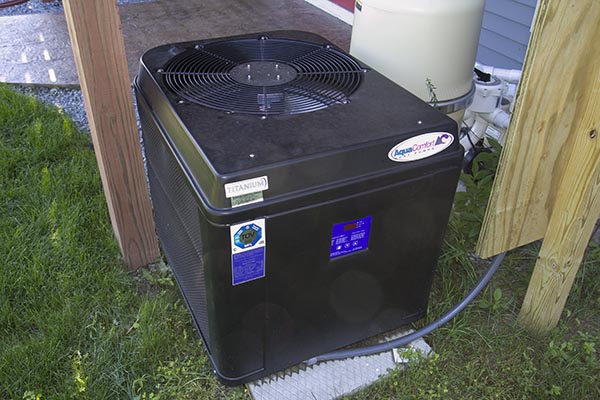









This is some great information, and I appreciate your point that gunite in-ground pools are the most durable. My husband and I have been wanting to get a pool put in our yard for a while, and we are finally in a financial situation that will allow us to. We’ll definitely look into getting the excavation started right away, and we’ll look into getting gunite for its durability. Thanks for the great post!
This is great information, but let me just add a bit of information based on my experience. We recently retired and were looking to build a low maintenance in our new home. We chose a mid sized fiberglass pool (16 x 30) that was large enough to enjoy yet small enough for me to maintain. A heat pump was a more expensive investment than a heater, but the cost to heat from April to October in Minnesota is only a few hundred dollars (and I keep the pool at 86 in the cooler weather). An automatic pool cover greatly reduces maintenance and increases safety. Because the fiberglass pool has no true 90 degree angles, you don’t get algae blooms. Maintenance is a bi-weekly backwash, brushing down the sides of the pool a few times during the summer, throwing the robot in twice a week, and refilling the bromine tablets in the chemical feeder when needed. I check the water balance twice a week and the bromine, pH, alkalinity etc. are always spot on. If I had to do it again, without a doubt I would choose fiberglass, a heat pump and an automatic pool cover.
Thanks for a great website, Todd! I’ve learned so much from your postings!